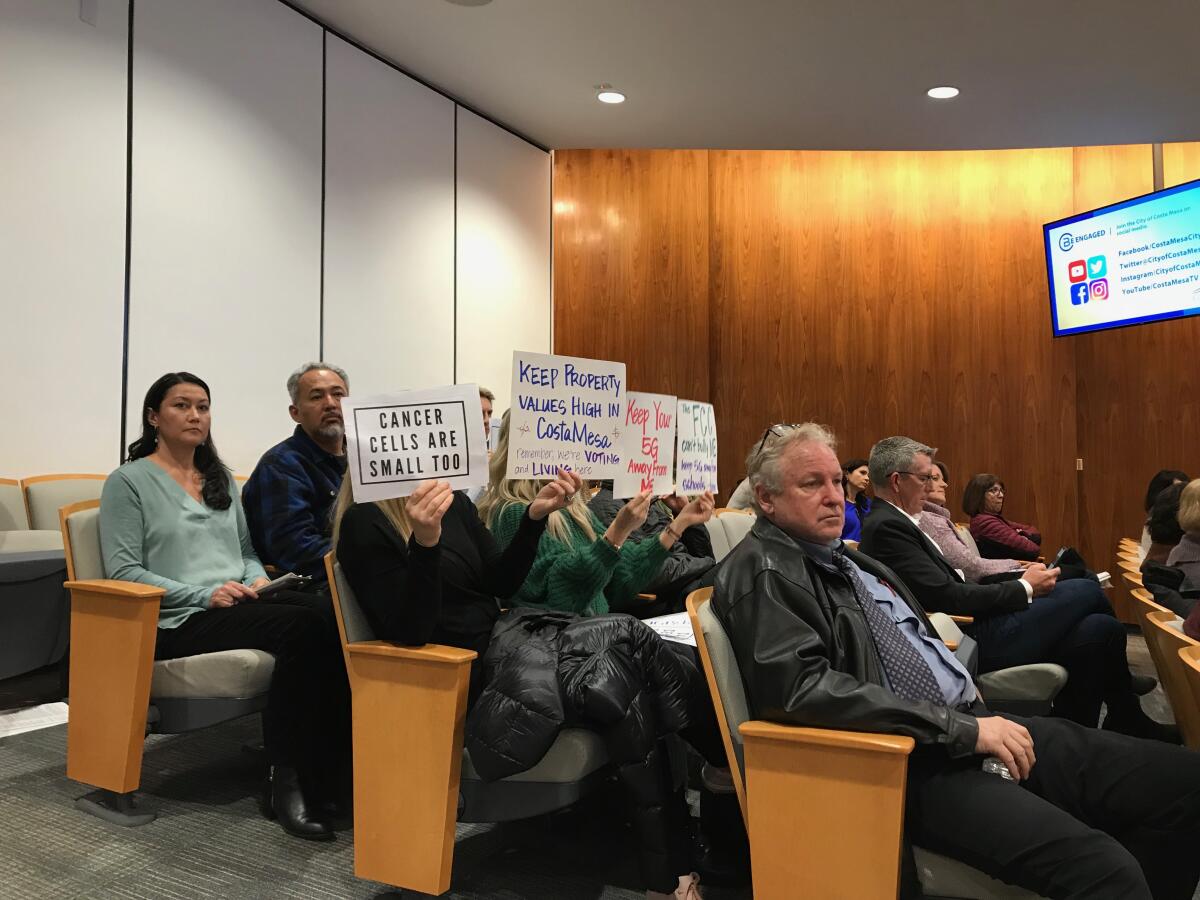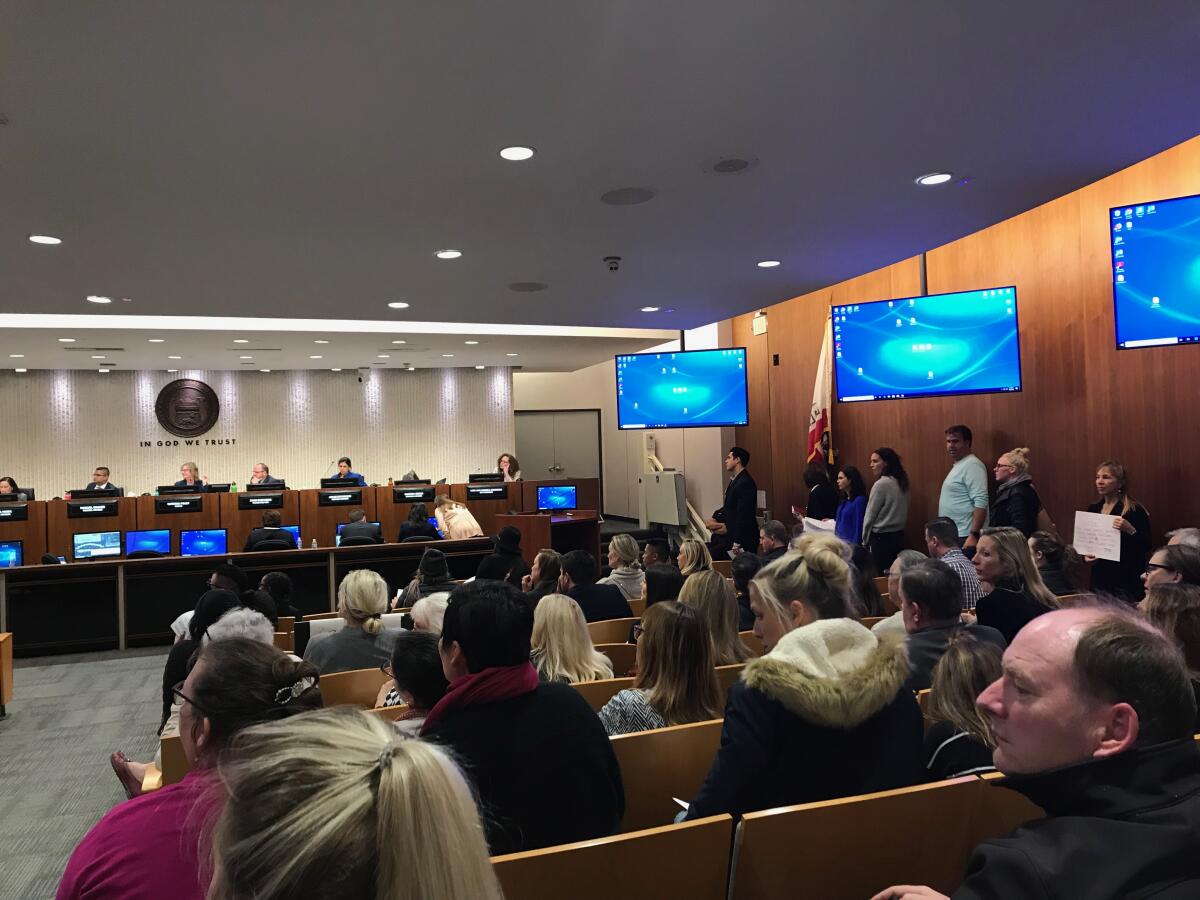Costa Mesa approves updated wireless communications ordinance with an ear to community concerns

- Share via
Dozens of people packing the Costa Mesa City Council chamber Tuesday night raised homemade signs. They hugged. They cried. They beseeched the council to beware of potential health risks of 5G technology — which they fear will likely make its way to Costa Mesa once the council had updated its policies on wireless communication facilities.
In October, the council approved a set of changes in design guidelines for wireless technology boxes, and on Tuesday considered more changes to city regulations.
After nearly five hours of discussion, about 30 speakers and an impromptu closed session, the council offered some concessions for the concerned community members.
But for some members of the Costa Mesa Advocacy Group, a grassroots organization that opposes expansive infrastructure for small cell facilities, the allowances weren’t enough.
“We’ve spent hours and hours with our expert attorney to improve this ordinance and make it actually make sense. Staff continues to ignore them and act as a gatekeeper preventing any real material change from happening,” Costa Mesa Advocacy Group leader Alison Burchette said in an email Wednesday morning. “Thus making it so that [the City Council] had to try to bake a dang cake at midnight with a heap of ingredients.”
Most notably, the council, on a 6-1 vote, changed a requirement in the ordinance to make it so that small wireless communication facilities — which typically take the form of small boxes on street poles — must be 750 feet from other communication facilities of the same company. Some community members had asked to increase the originally proposed 500-foot separation to at least 1,000 feet.
The small cells can be 250 feet from facilities of other companies, and even closer in non-residential zones.
The council also changed a requirement that the Planning Commission had added two weeks earlier. Under the new ordinance, residents who opt in may receive an email every time a wireless provider applies to install a new small cell box, or any time a provider asks to swap out 4G technology for 5G. Members of the public had called for all applications to be publicly noticed.
The council kept some other measures that community members lamented, such as that small cells installed near residential properties must maintain a 25-foot distance. That’s not far enough away for many residents, who complained that close proximity to the sites can be harmful for people with electromagnetic sensitivity.
5G is a fifth-generation wireless network that is intended to increase internet speeds and provide more-reliable connections. But many residents in Orange County and throughout the state have expressed concerns with the technology, which activists feel could endanger public health because of the use of higher-frequency radio waves.
Several health professionals joined the Costa Mesa Advocacy Group in warning council members of potentially harmful effects of radio waves.
“Years ago, smoking was the thing to do,” said Charlie Fagenholz, a holistic chiropractic physician. “Looking back, if you knew then what you knew now, would you vote for or against it? We’re in the same boat with [electromagnetic] toxicity.”
Some residents recounted personal stories of struggling with health issues that they attributed to high exposure to electromagnetic frequencies. Some expressed concern about the potential effects of radio frequencies on children. Others thought small cells are ugly and would ruin Costa Mesa’s aesthetics. At several points, Mayor Katrina Foley asked members of the crowd to quiet their applause.

Tim Brown, a government-affairs manager for Crown Castle, a communications infrastructure provider, said small cells are needed to provide bandwidth and capacity that are not possible with current infrastructure.
“The reason why these sites are developed is because people want them to work,” Brown said. “We have to respond to those demands. … The way we do that is by developing the infrastructure we have here.”
Other representatives of telecommunication companies such as AT&T and Verizon thanked the council for their review and reminded the audience that the Federal Communications Commission has not determined that radio frequency emissions from wireless devices adversely affect human health.
“The weight of scientific evidence has not effectively linked exposure to radio frequency energy from mobile devices with any known health problems,” an FCC statement reads, citing research from the Food and Drug Administration and the World Health Organization.
Council members emphasized that they can only make incremental changes to the ordinance because their hands are tied by the federal government’s regulations.
Many guidelines for the infrastructure of wireless communication facilities are federally mandated, though cities have a little leeway in regulating their aesthetics. Federal law, for instance, prohibits local governments from regulating construction of wireless telecommunication facilities based on perceived health effects.
At the end of the night’s exchange about wireless communications that stretched past midnight, Councilman Allan Mansoor voted against the proposed changes.
“I like the direction that we’re going, but I believe it’s rushed,” Mansoor said. “After midnight, our votes aren’t always the best. … I think we can do better.”
His comment provoked a tense exchange with other council members who challenged him to suggest concrete ways to improve the ordinance.
“Staff has done a really good job of trying to get us through all the land mines and be able to try to balance all the interests of protecting the community and addressing the concerns that were made, as well as addressing the concerns of the telecommunications industry,” Foley said, “and then trying to do something in a space where we really don’t have a lot of jurisdiction given to us at all by the federal government.”
The council will take a second, final vote on the changes at a future meeting.
All the latest on Orange County from Orange County.
Get our free TimesOC newsletter.
You may occasionally receive promotional content from the Daily Pilot.




